新概念英语第三册重点句子及解析Lesson38
- 格式:docx
- 大小:40.99 KB
- 文档页数:8
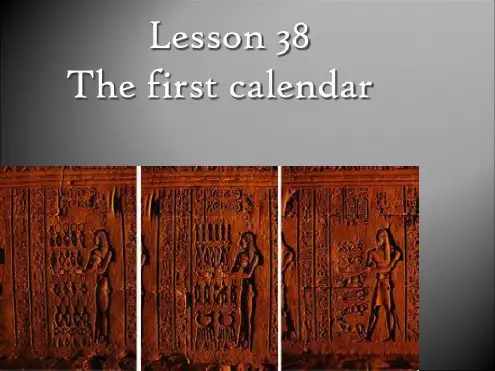
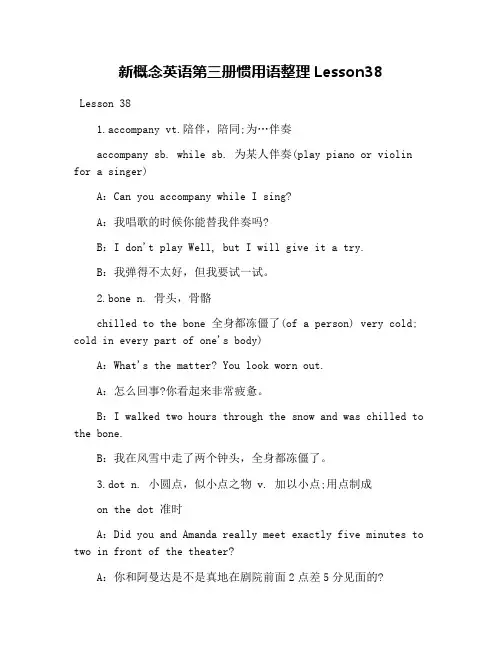
新概念英语第三册惯用语整理Lesson38Lesson 381.accompany vt.陪伴,陪同;为…伴奏accompany sb. while sb. 为某人伴奏(play piano or violin for a singer)A:Can you accompany while I sing?A:我唱歌的时候你能替我伴奏吗?B:I don't play Well, but I will give it a try.B:我弹得不太好,但我要试一试。
2.bone n. 骨头,骨骼chilled to the bone 全身都冻僵了(of a person) very cold; cold in every part of one's body)A:What's the matter? You look worn out.A:怎么回事?你看起来非常疲惫。
B:I walked two hours through the snow and was chilled to the bone.B:我在风雪中走了两个钟头,全身都冻僵了。
3.dot n. 小圆点,似小点之物 v. 加以小点;用点制成on the dot 准时A:Did you and Amanda really meet exactly five minutes to two in front of the theater?A:你和阿曼达是不是真地在剧院前面2点差5分见面的?B:Yes, we were both on the dot.B:是啊,我们两个都准时到达。
4.face v. 面对;面向;朝着(be) faced with 面对,面临 (with a certain problem to handle; confront)例句:For the earliest times people were faced with the problem of sending messages over long distances.从人类早期起,人们就面临着远距离传送信息这个问题。
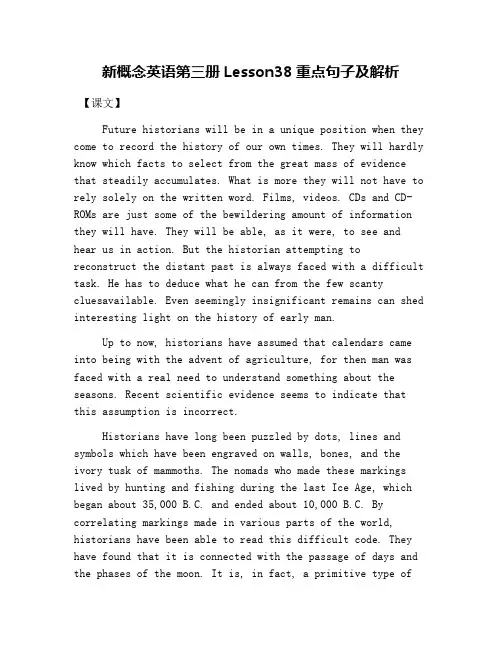
新概念英语第三册Lesson38重点句子及解析【课文】Future historians will be in a unique position when they come to record the history of our own times. They will hardly know which facts to select from the great mass of evidence that steadily accumulates. What is more they will not have to rely solely on the written word. Films, videos. CDs and CD-ROMs are just some of the bewildering amount of information they will have. They will be able, as it were, to see and hear us in action. But the historian attempting to reconstruct the distant past is always faced with a difficult task. He has to deduce what he can from the few scanty cluesavailable. Even seemingly insignificant remains can shed interesting light on the history of early man.Up to now, historians have assumed that calendars came into being with the advent of agriculture, for then man was faced with a real need to understand something about the seasons. Recent scientific evidence seems to indicate that this assumption is incorrect.Historians have long been puzzled by dots, lines and symbols which have been engraved on walls, bones, and the ivory tusk of mammoths. The nomads who made these markings lived by hunting and fishing during the last Ice Age, which began about 35,000 B.C. and ended about 10,000 B.C. By correlating markings made in various parts of the world, historians have been able to read this difficult code. They have found that it is connected with the passage of days and the phases of the moon. It is, in fact, a primitive type ofcalendar. It has long been known that the hunting scenes depicted on walls were not simply a form of artistic expression. They had a definite meaning, for they were asnear as early man could get to writing. It is possible that there is a definite relation between these paintings and the markings that sometimes accompany them. It seems that man was making a real effort to understand the seasons 20,000 years earlier than has been supposed.【课文翻译】未来的历史学家在写我们这个段历史的时候会别具一格。
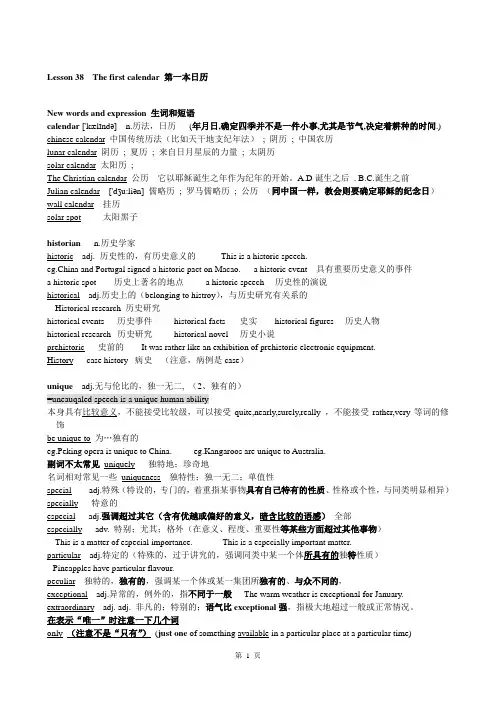
Lesson 38 The first calendar 第一本日历New words and expression 生词和短语calendar ['kælɪndə] n.历法,日历(年月日,确定四季并不是一件小事,尤其是节气,决定着耕种的时间.) chinese calendar 中国传统历法(比如天干地支纪年法); 阴历; 中国农历lunar calendar 阴历; 夏历; 来自日月星辰的力量; 太阴历solar calendar 太阳历;The Christian calendar 公历它以耶稣诞生之年作为纪年的开始。
A.D诞生之后. B.C.诞生之前Julian calendar ['dʒu:liən] 儒略历; 罗马儒略历; 公历(同中国一样,教会则要确定耶稣的纪念日)wall calendar 挂历solar spot 太阳黑子historian n.历史学家historic adj. 历史性的,有历史意义的-- This is a historic speech.eg.China and Portugal signed a historic pact on Macao. a historic event 具有重要历史意义的事件a historic spot 历史上著名的地点 a historic speech 历史性的演说historical adj.历史上的(belonging to histroy),与历史研究有关系的-- Historical research 历史研究historical events 历史事件historical facts 史实historical figures 历史人物historical research 历史研究historical novel 历史小说prehistoric 史前的It was rather like an exhibition of prehistoric electronic equipment.History case history 病史(注意,病例是case)unique adj.无与伦比的,独一无二, (2、独有的)=uneauqaled speech is a unique human ability本身具有比较意义,不能接受比较级,可以接受quite,nearly,surely,really ,不能接受rather,very等词的修饰be unique to 为…独有的eg.Peking opera is unique to China. eg.Kangaroos are unique to Australia.副词不太常见uniquely 独特地;珍奇地名词相对常见一些uniqueness 独特性;独一无二;单值性special adj.特殊(特设的,专门的,着重指某事物具有自己特有的性质、性格或个性,与同类明显相异)specially 特意的especial adj.强调超过其它(含有优越或偏好的意义,暗含比较的语感)全部especially adv. 特别;尤其;格外(在意义、程度、重要性等某些方面超过其他事物)-- This is a matter of especial importance. -- This is a especially important matter.particular adj.特定的(特殊的,过于讲究的,强调同类中某一个体所具有的独特性质)--Pineapples have particular flavour.peculiar 独特的,独有的,强调某一个体或某一集团所独有的、与众不同的,exceptional adj.异常的,例外的,指不同于一般-- The warm weather is exceptional for January. extraordinary adj. adj. 非凡的;特别的;语气比exceptional强,指极大地超过一般或正常情况。
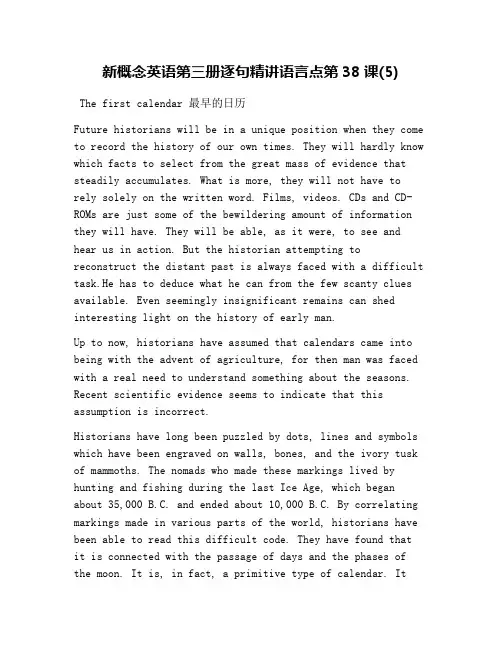
新概念英语第三册逐句精讲语言点第38课(5)The first calendar 最早的日历Future historians will be in a unique position when they come to record the history of our own times. They will hardly know which facts to select from the great mass of evidence that steadily accumulates. What is more, they will not have torely solely on the written word. Films, videos. CDs and CD-ROMs are just some of the bewildering amount of information they will have. They will be able, as it were, to see and hear us in action. But the historian attempting to reconstruct the distant past is always faced with a difficult task.He has to deduce what he can from the few scanty clues available. Even seemingly insignificant remains can shed interesting light on the history of early man.Up to now, historians have assumed that calendars came into being with the advent of agriculture, for then man was faced with a real need to understand something about the seasons. Recent scientific evidence seems to indicate that this assumption is incorrect.Historians have long been puzzled by dots, lines and symbols which have been engraved on walls, bones, and the ivory tusk of mammoths. The nomads who made these markings lived by hunting and fishing during the last Ice Age, which began about 35,000 B.C. and ended about 10,000 B.C. By correlating markings made in various parts of the world, historians have been able to read this difficult code. They have found that it is connected with the passage of days and the phases of the moon. It is, in fact, a primitive type of calendar. Ithas long been known that the hunting scenes depicted on walls were not simply a form of artistic expression. They had a definite meaning, for they were as near as early man could get to writing. It is possible that there is a definite relation between these paintings and the markings that sometimes accompany them. It seems that man was making a real effort to understand the seasons 20,000 years earlier than has been supposed.13.By correlating markings made in various parts of the world, historians have been able to read this difficult code.历史学家通过把世界各地留下的这种痕迹放在一起研究,终于弄懂了这种费解的代码。
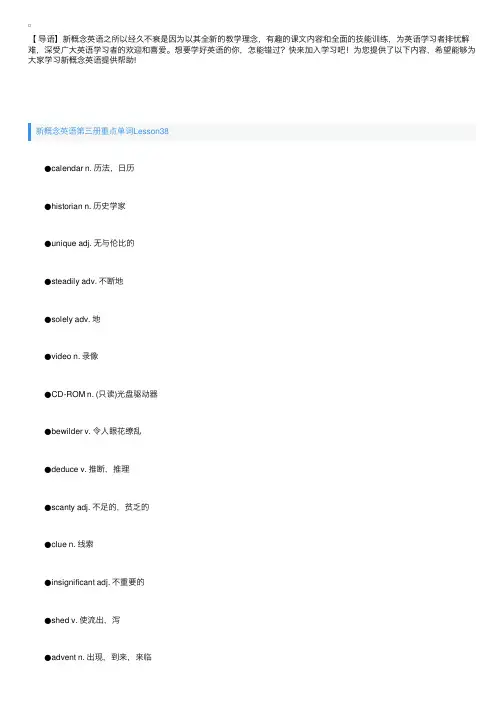
【导语】新概念英语之所以经久不衰是因为以其全新的教学理念,有趣的课⽂内容和全⾯的技能训练,为英语学习者排忧解难,深受⼴⼤英语学习者的欢迎和喜爱。
想要学好英语的你,怎能错过?快来加⼊学习吧!为您提供了以下内容,希望能够为⼤家学习新概念英语提供帮助!新概念英语第三册重点单词Lesson38 ●calendar n. 历法,⽇历 ●historian n. 历史学家 ●unique adj. ⽆与伦⽐的 ●steadily adv. 不断地 ●solely adv. 地 ●video n. 录像 ●CD-ROM n. (只读)光盘驱动器 ●bewilder v. 令⼈眼花缭乱 ●deduce v. 推断,推理 ●scanty adj. 不⾜的,贫乏的 ●clue n. 线索 ●insignificant adj. 不重要的 ●shed v. 使流出,泻 ●advent n. 出现,到来,来临 ●agriculture n. 农业 ●assumption n. 假定,设想 ●dot n. ⼩圆点 ●symbol n. 符号 ●engrave v. 雕刻 ●ivory n. 象⽛制品 ●mammoth n. (古)长⽑象 ●phase n. ⽉相,天相 ●tusk n. 獠⽛,长⽛、象⽛ ●primitive adj. 原始的 ●nomad n. 游牧民 ●depict v. 描画,描绘 ●correlate v. 使相互联系新概念英语第三册重点单词Lesson39 ●rough adj. 崎岖不平的 ●boulder n. ⼤⽯块 ●pit v. 使得坑坑洼洼 ●perturb v. 使不安 ●underestimate v. 低估 ●swerve v. 争转变 ●scoop v. 挖出 ●hammer v. (⽤锤)击打,锤打 ●ominously adv. 有预兆的,不祥的 ●rip v. 划破,撕,扯 ●petrol n. 汽油 ●stretch n. ⼀⼤⽚(平地或⽔) ●obstacle n. 障碍 ●clump n. 丛,簇 ●fissure n. (⽯、地的)深缝 ●renew v. 重复 ●pleading n. 恳求 ●gear n. (汽车)排档 ●astride prep. 骑,跨 ●crack n. 缝隙 ●zigzag n. “之”字形 ●shallow adj. 浅的 ●grind (ground, ground ) v. 磨擦 ●halt n. 停 ●dashboard n. (汽车上的)仪表盘新概念英语第三册重点单词Lesson40 ●hoax n. 骗局,戏弄 ●deception n. 欺骗,骗局 ●self-respecting adj. ⾃重的 ●indulge v. 使沉迷 ●pneumatic adj. ⽓动的 ●drill n. 钻 ●silly adj. ⽆意义的,⽆聊的 ●advance adj. 预先的,事先获得的 ●archway n. 拱形门楼 ●remonstrate v. 规劝,告诫 ●ironically adv. 讽刺地 ●permission n. 许可 ●grant v. 同意,准予 ■hoax n. 骗局,戏弄 play a hoax on sb. 戏弄某⼈ play a trick on sb. 戏弄某⼈ play a joke on sb. 开某⼈玩笑。
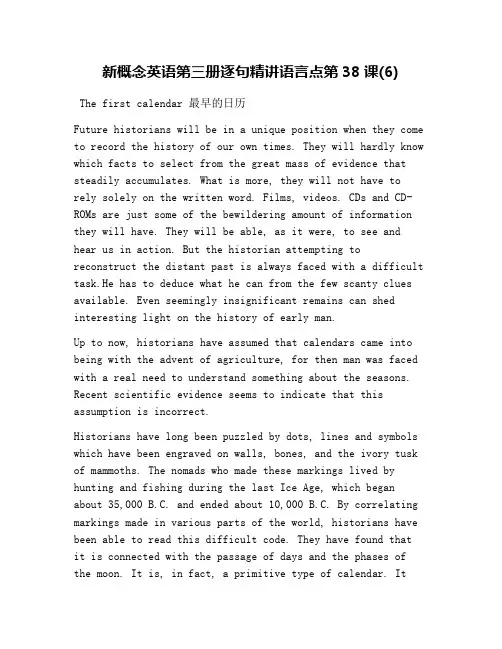
新概念英语第三册逐句精讲语言点第38课(6)The first calendar 最早的日历Future historians will be in a unique position when they come to record the history of our own times. They will hardly know which facts to select from the great mass of evidence that steadily accumulates. What is more, they will not have torely solely on the written word. Films, videos. CDs and CD-ROMs are just some of the bewildering amount of information they will have. They will be able, as it were, to see and hear us in action. But the historian attempting to reconstruct the distant past is always faced with a difficult task.He has to deduce what he can from the few scanty clues available. Even seemingly insignificant remains can shed interesting light on the history of early man.Up to now, historians have assumed that calendars came into being with the advent of agriculture, for then man was faced with a real need to understand something about the seasons. Recent scientific evidence seems to indicate that this assumption is incorrect.Historians have long been puzzled by dots, lines and symbols which have been engraved on walls, bones, and the ivory tusk of mammoths. The nomads who made these markings lived by hunting and fishing during the last Ice Age, which began about 35,000 B.C. and ended about 10,000 B.C. By correlating markings made in various parts of the world, historians have been able to read this difficult code. They have found that it is connected with the passage of days and the phases of the moon. It is, in fact, a primitive type of calendar. Ithas long been known that the hunting scenes depicted on walls were not simply a form of artistic expression. They had a definite meaning, for they were as near as early man could get to writing. It is possible that there is a definite relation between these paintings and the markings that sometimes accompany them. It seems that man was making a real effort to understand the seasons 20,000 years earlier than has been supposed.16.It has long been known that the hunting scenes depicted on walls were not simply a form of artistic expression.大家早就知道,画在墙上的狩猎图景并不是单纯的艺术表现形式。
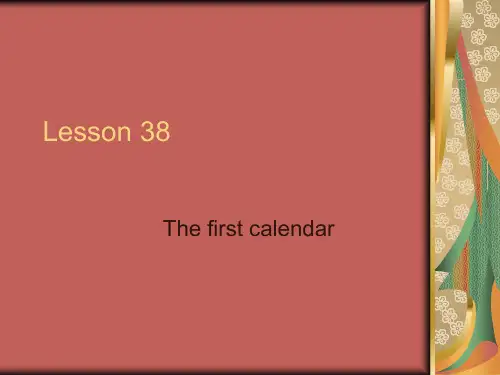
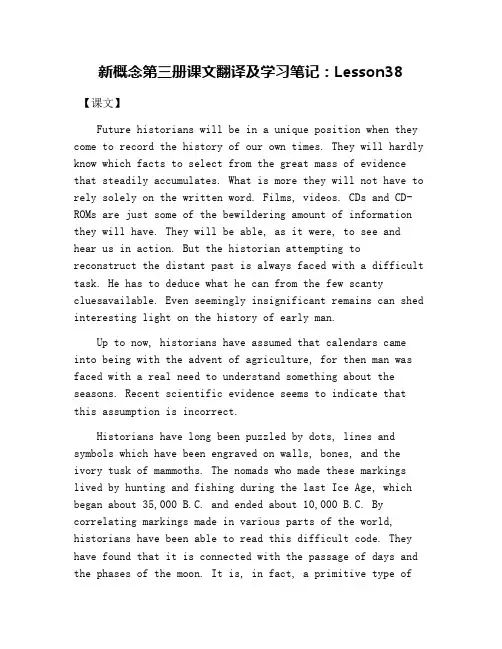
新概念第三册课文翻译及学习笔记:Lesson38【课文】Future historians will be in a unique position when they come to record the history of our own times. They will hardly know which facts to select from the great mass of evidence that steadily accumulates. What is more they will not have to rely solely on the written word. Films, videos. CDs and CD-ROMs are just some of the bewildering amount of information they will have. They will be able, as it were, to see and hear us in action. But the historian attempting to reconstruct the distant past is always faced with a difficult task. He has to deduce what he can from the few scanty cluesavailable. Even seemingly insignificant remains can shed interesting light on the history of early man.Up to now, historians have assumed that calendars came into being with the advent of agriculture, for then man was faced with a real need to understand something about the seasons. Recent scientific evidence seems to indicate that this assumption is incorrect.Historians have long been puzzled by dots, lines and symbols which have been engraved on walls, bones, and the ivory tusk of mammoths. The nomads who made these markings lived by hunting and fishing during the last Ice Age, which began about 35,000 B.C. and ended about 10,000 B.C. By correlating markings made in various parts of the world, historians have been able to read this difficult code. They have found that it is connected with the passage of days and the phases of the moon. It is, in fact, a primitive type ofcalendar. It has long been known that the hunting scenes depicted on walls were not simply a form of artistic expression. They had a definite meaning, for they were asnear as early man could get to writing. It is possible that there is a definite relation between these paintings and the markings that sometimes accompany them. It seems that man was making a real effort to understand the seasons 20,000 years earlier than has been supposed.【课文翻译】未来的历史学家在写我们这个段历史的时候会别具一格。
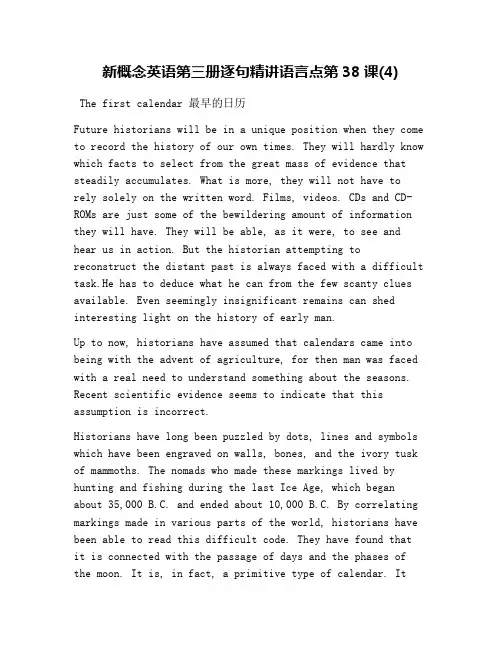
新概念英语第三册逐句精讲语言点第38课(4)The first calendar 最早的日历Future historians will be in a unique position when they come to record the history of our own times. They will hardly know which facts to select from the great mass of evidence that steadily accumulates. What is more, they will not have torely solely on the written word. Films, videos. CDs and CD-ROMs are just some of the bewildering amount of information they will have. They will be able, as it were, to see and hear us in action. But the historian attempting to reconstruct the distant past is always faced with a difficult task.He has to deduce what he can from the few scanty clues available. Even seemingly insignificant remains can shed interesting light on the history of early man.Up to now, historians have assumed that calendars came into being with the advent of agriculture, for then man was faced with a real need to understand something about the seasons. Recent scientific evidence seems to indicate that this assumption is incorrect.Historians have long been puzzled by dots, lines and symbols which have been engraved on walls, bones, and the ivory tusk of mammoths. The nomads who made these markings lived by hunting and fishing during the last Ice Age, which began about 35,000 B.C. and ended about 10,000 B.C. By correlating markings made in various parts of the world, historians have been able to read this difficult code. They have found that it is connected with the passage of days and the phases of the moon. It is, in fact, a primitive type of calendar. Ithas long been known that the hunting scenes depicted on walls were not simply a form of artistic expression. They had a definite meaning, for they were as near as early man couldget to writing. It is possible that there is a definiterelation between these paintings and the markings that sometimes accompany them. It seems that man was making a real effort to understand the seasons 20,000 years earlier thanhas been supposed.10. Recent scientific evidence seems to indicate that this assumption is incorrect.但近期科学研究发现,好像这种假设是不准确的。
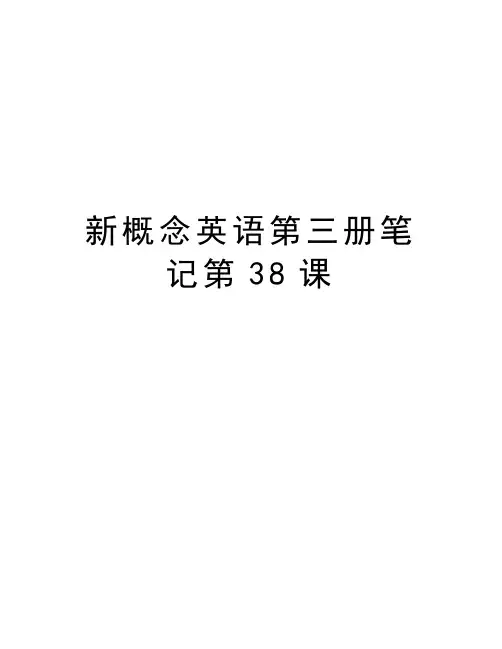
新概念英语第三册笔记第38课Lesson 38 The first calendar 第一本日历New words and expression 生词和短语calendar ['kælɪndə] n.历法,日历 (年月日,确定四季并不是一件小事,尤其是节气,决定着耕种的时间.)chinese calendar 中国传统历法(比如天干地支纪年法) ; 阴历 ; 中国农历lunar calendar 阴历 ; 夏历 ; 来自日月星辰的力量 ; 太阴历solar calendar 太阳历 ;The Christian calendar 公历它以耶稣诞生之年作为纪年的开始。
A.D诞生之后 . B.C.诞生之前Julian calendar ['dʒu:liən] 儒略历 ; 罗马儒略历 ; 公历(同中国一样,教会则要确定耶稣的纪念日)wall calendar 挂历solar spot 太阳黑子historian n.历史学家historic adj. 历史性的,有历史意义的 -- This is a historic speech.eg.China and Portugal signed a historic pact on Macao. a historic event 具有重要历史意义的事件a historic spot 历史上著名的地点 a historic speech 历史性的演说historical adj.历史上的(belonging to histroy),与历史研究有关系的-- Historical research 历史研究historical events 历史事件 historical facts 史实 historical figures 历史人物historical research 历史研究 historical novel 历史小说prehistoric 史前的 It was rather like an exhibition of prehistoric electronic equipment.History case history 病史(注意,病例是case)unique adj.无与伦比的,独一无二, (2、独有的)=uneauqaled speech is a unique human ability本身具有比较意义,不能接受比较级,可以接受quite,nearly,surely,really ,不能接受rather,very等词的修饰be unique to 为…独有的eg.Peking opera is unique to China. eg.Kangaroos are unique to Australia.副词不太常见uniquely 独特地;珍奇地名词相对常见一些 uniqueness 独特性;独一无二;单值性special adj.特殊(特设的,专门的,着重指某事物具有自己特有的性质、性格或个性,与同类明显相异)specially 特意的especial adj.强调超过其它(含有优越或偏好的意义,暗含比较的语感)全部especially adv. 特别;尤其;格外(在意义、程度、重要性等某些方面超过其他事物)-- This is a matter of especial importance. -- This is a especially important matter.particular adj.特定的(特殊的,过于讲究的,强调同类中某一个体所具有的独特性质)--Pineapples have particular flavour.peculiar 独特的,独有的,强调某一个体或某一集团所独有的、与众不同的,exceptional adj.异常的,例外的,指不同于一般-- The warm weather is exceptional for January. extraordinary adj. adj. 非凡的;特别的;语气比exceptional强,指极大地超过一般或正常情况。
新概念英语第三册课文翻译及学习笔记:Lesson38【课文】Future historians will be in a unique position when they come to record the history of our own times. They will hardly know which facts to select from the great mass of evidence that steadily accumulates. What is more they will not have to rely solely on the written word. Films, videos. CDs and CD-ROMs are just some of the bewildering amount of information they will have. They will be able, as it were, to see and hear us in action. But the historian attempting to reconstruct the distant past is always faced with a difficult task. He has to deduce what he can from the few scanty cluesavailable. Even seemingly insignificant remains can shed interesting light on the history of early man.Up to now, historians have assumed that calendars came into being with the advent of agriculture, for then man was faced with a real need to understand something about the seasons. Recent scientific evidence seems to indicate that this assumption is incorrect.Historians have long been puzzled by dots, lines and symbols which have been engraved on walls, bones, and the ivory tusk of mammoths. The nomads who made these markings lived by hunting and fishing during the last Ice Age, which began about 35,000 B.C. and ended about 10,000 B.C. By correlating markings made in various parts of the world, historians have been able to read this difficult code. They have found that it is connected with the passage of days and the phases of the moon. It is, in fact, a primitive type ofcalendar. It has long been known that the hunting scenes depicted on walls were not simply a form of artistic expression. They had a definite meaning, for they were asnear as early man could get to writing. It is possible that there is a definite relation between these paintings and the markings that sometimes accompany them. It seems that man was making a real effort to understand the seasons 20,000 years earlier than has been supposed.【课文翻译】未来的历史学家在写我们这个段历史的时候会别具一格。
【Multiple choice questions】 Comprehension 1 In assuming that calendars came into being with the advent of agriculture, historians madethe mistake of _____ . a. relying solely on the written word b. disregarding the markings that early man had been responsible for c. supposing that nomadic man had no reason to understand the seasons d. not connecting the passage of days with the phasesof the moon 2 The scientific evidence that has recently come to light is that _____ . a. nomads engraved the bones and tusks of the animals they killed b. noads lived by hunting and fishing c. nomads travelled widely in various parts of the world d. the markings made by variousnomadic groups all have a definite pattern 3 The paintings which have been found on the walls of nomadic dwelling places _____ . a. have taught historians something about the nomadic way of life b. have no other content than their artistic merit c. are not thought to be connected with an ancient calendar system d. are invariably accompanied by odd dots, lines and symbols Structure 4 It _____ as if they could see nad hear us in action. (ll.6-7)a. wasb. werec. should bed. will be 5 Even _____ seem insignificant remains can shed interesting … (ll.8-9)a. theyb. whichc. whatd. those to 6 Historians are now able to read this difficult code _____ markings made in … (ll.15-16)a. with correlatingb. having correlatedc. which correlatesd. for they correlate 7 _____ be a definite relation between these paintings and the …(ll.19-21)a. It couldb. There canc. There mayd. It might Vocabulary 8 Historians have long tried to _____ dots, lines and … (l.13)a. puzzleb. puzzle outc. riddled. detect 9 By correlating markings made in _____ parts of the world … (ll.15-16)a. differentb. severalc. manyd. other 10 ---- historians have been able to read _____ . (l.16)a. these puzzling signsb. this hard lawc. thesedifficult signalsd. this uneasy letter 11 Until recently historians assumed that calendars _____ with the advent of agriculture. (l.10)a. came to existenceb. came toexistingc. cme to existd. were existential come to +动词原形: come to record ; come to exist ; come into existence 12 The people who lived by hunting and fishing during the last Ice Age _____ .(ll.14-15)a. wandered from place to placeb. lived in villagesc. first learnt to writed. learnt how to farmthe land 【Key to Multiple choice questions】1. B2. D3. A4. D5. C6. B7. C8. B9. A 10. A 11. C 12. A。
新概念英语第三册逐句精讲语言点第38课(3)The first calendar 最早的日历Future historians will be in a unique position when they come to record the history of our own times. They will hardly know which facts to select from the great mass of evidence that steadily accumulates. What is more, they will not have torely solely on the written word. Films, videos. CDs and CD-ROMs are just some of the bewildering amount of information they will have. They will be able, as it were, to see and hear us in action. But the historian attempting to reconstruct the distant past is always faced with a difficult task.He has to deduce what he can from the few scanty clues available. Even seemingly insignificant remains can shed interesting light on the history of early man.Up to now, historians have assumed that calendars came into being with the advent of agriculture, for then man was faced with a real need to understand something about the seasons. Recent scientific evidence seems to indicate that this assumption is incorrect.Historians have long been puzzled by dots, lines and symbols which have been engraved on walls, bones, and the ivory tusk of mammoths. The nomads who made these markings lived by hunting and fishing during the last Ice Age, which began about 35,000 B.C. and ended about 10,000 B.C. By correlating markings made in various parts of the world, historians have been able to read this difficult code. They have found that it is connected with the passage of days and the phases of the moon. It is, in fact, a primitive type of calendar. Ithas long been known that the hunting scenes depicted on walls were not simply a form of artistic expression. They had a definite meaning, for they were as near as early man could get to writing. It is possible that there is a definite relation between these paintings and the markings that sometimes accompany them. It seems that man was making a real effort to understand the seasons 20,000 years earlier than has been supposed.7.He has to deduce what he can from the few scanty clues available.他们必须根据现有的不充分的线索实行推理。
新概念英语第三册课堂笔记:第38课Lesson 38 The first calender 最早的日历【New words and expressions】生词和短语●calendar n. 历法,日历●historian n. 历史学家●unique adj. 无与伦比的●steadily adv. 持续地●solely adv. 地●video n. 录像●CD-ROM n. (只读)光盘驱动器●bewilder v. 令人眼花缭乱●deduce v. 推断,推理●scanty adj. 不足的,贫乏的●clue n. 线索●insignificant adj. 不重要的●shed v. 使流出,泻●advent n. 出现,到来,来临●agriculture n. 农业●assumption n. 假定,设想●dot n. 小圆点●symbol n. 符号●engrave v. 雕刻●ivory n. 象牙制品●mammoth n. (古)长毛象●ph ase n. 月相,天相●tusk n. 獠牙,长牙、象牙●primitive adj. 原始的●nomad n. 游牧民●depict v. 描画,描绘●correlate v. 使相互联系■calendar n. 历法,日历calender 轮压机■historian n. 历史学家historic 具有历史意义的This is a historic speech. historical 与历史研究相关系的historical research 历史研究■unique adj. 无与伦比的unique: uneaqualedSpeech is a unique human abilityunique 不能接受比较级,能够接受quite, almost, nearly, surely, really等修饰,但不能接受rather,very等词的修饰。
新概念英语第三册Lesson38~40重点句型解析新概念英语第三册Lesson38重点句型解析1、What is more they will not have to rely solely on the written word.what is more 更有甚者,起到承接上下文的作用,是furthermore,moreover 的意思what is worse 更糟糕的是rely on = count on = depend on 依靠、指望-- you can`t rely on others.-- He can`t be relied on / depended on / counted on.solely adv.地整理发布:kaiziliu=only , just , nearly2、They will be able, as it were, to see and hear us in action.in action 行动中的,活动中的as it were 能够说,似乎,好象,是一个插入语,在语法上是一个独立成分,能够用于任何时态语句中。
-- He is as it were a walking dictionary. 他能够说是一本活字典。
-- Computers can never as it were lead independent lives. 电脑不能过独立的生活。
As it is = in fact = in reality = actually = as a matter of fact 事实上-- I thought things would get better,but as it is ,they are getting worse.-- In many ways children live as it were in a different world from the adults.在很多方面,孩子能够说过着一种与大人完全不同的生活。
新概念英语第三册重点句子及解析Lesson38
【课文】
Future historians will be in a unique position when they come to record the history of our own times. They will hardly know which facts to select from the great mass of evidence that steadily accumulates. What is more they will not have to rely solely on the written word. Films, videos. CDs and CD-ROMs are just some of the bewildering amount of information they will have. They will be able, as it were, to see and hear us in action. But the historian attempting to reconstruct the distant past is always faced with a difficult task. He has to deduce what he can from the few scanty cluesavailable. Even seemingly insignificant remains can shed interesting light on the history of early man.
Up to now, historians have assumed that calendars came into being with the advent of agriculture, for then man was faced with a real need to understand something about the seasons. Recent scientific evidence seems to indicate that this assumption is incorrect.
Historians have long been puzzled by dots, lines and symbols which have been engraved on walls, bones, and the ivory tusk of mammoths. The nomads who made these markings lived by hunting and fishing during the last Ice Age, which began about 35,000 B.C. and ended about 10,000 B.C. By correlating markings made in various parts of the world, historians have been able to read this difficult code. They have found that it is connected with the passage of days and the phases of the moon. It is, in fact, a primitive type of
calendar. It has long been known that the hunting scenes depicted on walls were not simply a form of artistic expression. They had a definite meaning, for they were as
near as early man could get to writing. It is possible that there is a definite relation between these paintings and the markings that sometimes accompany them. It seems that man was making a real effort to understand the seasons 20,000 years earlier than has been supposed.
【课文翻译】
未来的历史学家在写我们这个段历史的时候会别具一格。
对于逐
渐积累起来的庞大材料,他们几乎不知道选择哪些好,而且,也不必
完全依赖文字材料。
电影、录像、光盘和光盘驱动器仅仅能为他们提
供令人眼花缭乱的大量信息的几种手段。
他们能够身临其境般地观看
我们做事,倾听我们讲话。
但是,历史学家企图重现遥远的过去不过
一项艰巨的任务,他们必须根据现有的不充分的线索实行推理。
即使
看起来微不足道的遗物,也可能揭示人类早期历史的一些有趣的内容。
历史学家迄今认为日历是随农业的问世而出现的,因为当时人们
面临着了解四季的实际需要,但近期科学研究发现,好像这种假设是
不准确的。
长期以来,历史学家一直对雕刻在墙壁上、骨头上、古代长毛象
的象牙上的点、线和形形色色的符号感到困惑不解。
这些痕迹是游牧
人留下的,他们生活在从公元前约 35,000年到公元前10000年的冰
川期的末期,以狩猎、捕鱼为生。
历史学家通过把世界各地留下的这
种痕迹放在一起究,终于弄懂了这种费解的代码。
他们发现代码与昼
夜更迭和月亮圆缺相关,事实上是一种最原始的日历。
大家早就知道,画在墙上的狩猎图景并不是单纯的艺术表现形式,它们有着一定的含义,因为它们已接近古代人的文字形式。
有时,这种图画与墙壁上的
刻痕共存,它们之间可能有一定的联系。
看来人类早就致力于探索四
季变迁了,比人们想像的要早20,000年。
【词汇】
calendar n. 历法,日历historian n. 历史学家
unique adj. 无与伦比的steadily adv. 持续地
solely adv. 地
video n. 录像
CD-ROM n. (只读)光盘驱动器bewildering adj. 令人眼花缭乱deduce v. 推断,推理
scanty adj. 不足的,贫乏的clue n. 线索
insignificant adj. 不重要的shed v. 使流出,泻
advent n. 出现,到来,来临agriculture n. 农业assumption n. 假定,设想
dot n. 小圆点
symbol n. 符号
engrave v. 雕刻
ivory n. 象牙制品。